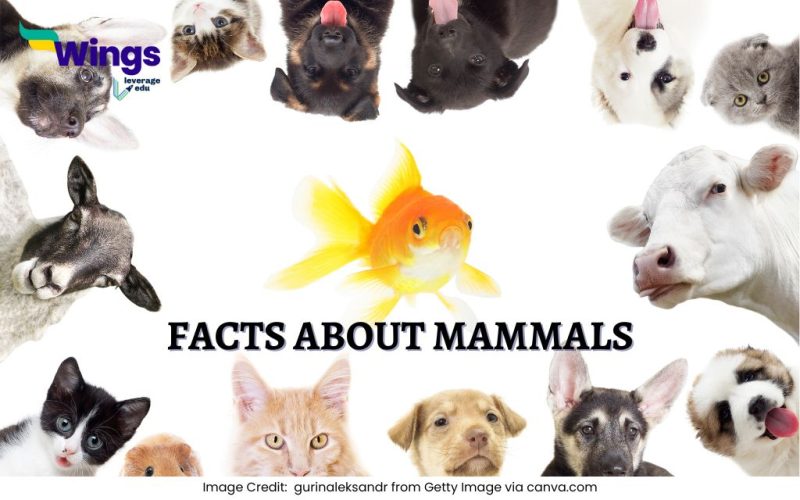We live on a planet packed with amazing animals, and mammals are a really special group that holds a special place on Earth. Think about it – from teeny shrews to giant blue whales, they all feed their babies milk and have other things that make them mammals. But get this: There’s a whole world of weird stuff mammals do, surprising ways they act, and strange twists in how they evolved that you probably haven’t even heard of. Get ready to be amazed by these cool facts about mammal life!
Table of Contents [show]
10 Amazing Facts About Mammals for Kids
| Facts | Basic Description | Key Examples |
| Produce Milk | Feed young with milk. | Humans, cats, whales |
| Have Hair/Fur | Usually have hair or fur. | Dogs, bears, seals |
| Breathe Air | Use lungs to breathe air. | Humans, dolphins, squirrels |
| Warm-Blooded | Control their own body heat. | Lions, horses, mice |
| Live Birth | Mostly born live. | Cats, cows, monkeys |
| Backbone | Have a spinal column. | All mammals |
| 4-Chamber Heart | Complex heart for efficient blood flow. | Humans, giraffes, bats |
| Larger Brains | Generally have bigger brains. | Primates, dolphins, dogs |
| Diverse Homes | Live in many different environments. | Deserts, oceans, forests, cities |
| Parental Care | Parents often care for their young. | Humans, wolves, elephants |
10+ Interesting Facts about Mammals for Kids
Here are some more interesting facts about mammal you would find amusing and fun to read:
1. Blue whales are the largest mammals on Earth.
Did you know this fun fact about whales? They are the largest animals on Earth, longer than a school bus. Their immense size is supported by the buoyancy of water and allows them to efficiently filter-feed on tiny krill.

2. Bats are the only mammals that can truly fly.
They have evolved wings formed from skin stretched between elongated fingers and their body. This unique adaptation allows them to exploit aerial insect prey and navigate in three-dimensional space.
3. Bats and dolphins are the only mammals that can”see” with sound.
Bats and dolphins make sounds and listen for the echoes to “see” what’s around them in the dark or murky water, helping them move around and find food.
4. Giraffes have super long tongues.
These animals have super long tongues, like almost a foot and a half! And they can use them like hands to grab leaves way up high in trees, getting food that other plant-eaters can’t reach. Pretty neat, huh?
5. As mammals, cheetahs are known for their incredible speed.
These mammals are the speed demons of the land! They’re made for quick sprints. Think light body, bendy back, and long legs with claws that always stay out – all perfect for catching speedy snacks.
6. Kangaroo rats are the only mammals that do not need water to survive.
Living in the desert is tough, right? Well, these critters are smart – they get all the water they need just from munching on seeds! Their bodies are super good at pulling out every last drop of water when they digest their food. That’s how they survive in those dry places. Moreover, here are some fun facts about kangaroos you should also know.
7. The capacity for hearing in elephants is quite advanced.
Elephants have huge ears and can hear really low sounds that travel far. This is like having a super-powered walkie-talkie, helping them chat with each other and hear danger even when they’re spread out over big areas. Keep the group together and safe!
8. Moles can feel underground soil vibrations.
Moles are creatures born with super-sensitive noses and a special kind of hair that can sense any movement in the ground, which also helps them to find their prey in the dark.
9. You can hardly differentiate koala fingerprints from human fingerprints.
These animals have tiny bumps on their skin, the same as humans, and these seem like our fingerprints.
10. These squirrels nearly turn into ice in the cold.
During the really cold winters, when there’s not much food around, these animals can basically power down! They make their bodies super cold, and their hearts beat really slowly, like they’re in a deep sleep. This helps them save a ton of energy until things get warmer and there’s more to eat. It’s like hitting the pause button on life!
11. Porcupines have tails with sharp things on them.
Porcupines’ tails are the real weapon that helps them attack their prey, so these animals have tails covered in pointy, prickly things that also break off super easily.

12. Beavers are the only mammals whose teeth never stop growing.
Not all the teeth, yes! The front one just keeps growing, but not the crazy long. So the reason is the front of the tooth is super hard, but the back is softer; that’s why you will see them chewing wood all the time.
13. Sloths are known for being slow.
Sloths are known as the chill mammals because they have a really slow body engine. So they don’t need much energy. Their special muscles make hanging upside down in trees easy, perfect for their relaxed leaf-eating life.
14. Camels store fat in humps.
Think of those humps like built-in snacks and water packs! They turn this stored fat into energy and water whenever it’s needed. This process is very important for them as they are living in a desert where food and water are hard to find. Have you ever thought about it? That the CAMEL have its full form.
15. Every zebra has its own stripe pattern.
Every zebra has their own special kind of stripe on their body. Just like we humans have our special fingerprints. Scientists figure these stripes might confuse predators in a crowd, help zebras know who’s who, or even keep them from getting too hot. It’s interesting, right? Then you should also check out these fascinating facts about zebras.
16. To breathe, whales go to the surface.
As we all know, whales live in water; they are also mammals like us, so they need to come up to the surface to breathe air using their lungs. They also have a special kind of nose on the tops of their heads called blowholes. They can also hold their breath for a long time as well; this is how they manage to live in the ocean.
17. Baby kangaroos stay in their mom’s pouch.
The baby kangaroos, called joeys, grow and develop inside a special pouch on their mother’s belly. This pouch helps them to stay safe and provide milk until they are big enough to move out.

18. Elephant babies take a long time to grow inside their moms.
Wow, get this – it takes almost two whole years before one of their babies is born! That super long time inside the mom means the baby has plenty of time to grow big and be pretty developed by the time it arrives. It’s like giving the baby a really long head start!
19. Moms and baby whales stay together for a long time.
These youngsters spend a good chunk of time learning from their parents how to find food and how to get along with others in their group. This long period of guidance really boosts their chances of staying alive. It’s like having extra time in school for survival!
20. You can find mammals all over the world.
These creatures are found absolutely everywhere – on every piece of land and in every ocean! They’re like the ultimate adaptable beings, with special features that let them live in all sorts of places, from super hot deserts to the freezing cold poles. Talk about being able to make any place home!
Isn’t it wild how different mammals are? They eat all sorts of crazy things and live in totally unique ways. It just goes to show you how amazing and flexible they are! There’s always some cool new thing to discover about these creatures, so keep wondering and learning about the animal world!
FAQs
Yes! The European shrew has a venomous bite that is used to kill its prey, and they also store venom for future use.
There is one mammal named the tiny tarsier that has very big eyes; each one is larger than its brain. Their bigger eye helps to catch even tiny movements of their prey during the day.
The giraffe has the longest tongue, and its length is up to 18 inches, which it uses to grab leaves from thorny branches.
No mammal can walk on water. However, a reptile called a basilisk can run across the water surface but for a shorter distance.
Find more interesting reads below!
| Funniest Animal Facts for Kids | Interesting Animal Facts for Kids |
| Facts About Sea Animals for Kids | Facts About Left-Handedness in Animals |
| Interesting Facts About Cheetahs | Facts About Endangered Animals |
This was all about the interesting facts about mammals. If you find the read interesting and wish to read more, then stay tuned to the General Knowledge page of Leverage Edu.
 One app for all your study abroad needs
One app for all your study abroad needs















 45,000+ students trusted us with their dreams. Take the first step today!
45,000+ students trusted us with their dreams. Take the first step today!
